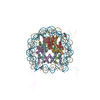+ データを開く
データを開く
- 基本情報
基本情報
| 登録情報 | データベース: EMDB / ID: EMD-8246 | ||||||||||||
|---|---|---|---|---|---|---|---|---|---|---|---|---|---|
| タイトル | Structural model of 53BP1 bound to a ubiquitylated and methylated nucleosome, at 4.5 A resolution | ||||||||||||
 マップデータ マップデータ | 53BP1 bound to a ubiquitylated and methylated nucleosome | ||||||||||||
 試料 試料 |
| ||||||||||||
 キーワード キーワード | DNA / chromatin / 53BP1 / STRUCTURAL PROTEIN-DNA complex | ||||||||||||
| 機能・相同性 |  機能・相同性情報 機能・相同性情報ubiquitin-modified histone reader activity / positive regulation of isotype switching / histone H4K20me2 reader activity / cellular response to X-ray / double-strand break repair via classical nonhomologous end joining / protein localization to site of double-strand break / hypothalamus gonadotrophin-releasing hormone neuron development / DNA repair complex / female meiosis I / positive regulation of protein monoubiquitination ...ubiquitin-modified histone reader activity / positive regulation of isotype switching / histone H4K20me2 reader activity / cellular response to X-ray / double-strand break repair via classical nonhomologous end joining / protein localization to site of double-strand break / hypothalamus gonadotrophin-releasing hormone neuron development / DNA repair complex / female meiosis I / positive regulation of protein monoubiquitination / fat pad development / mitochondrion transport along microtubule / telomeric DNA binding / female gonad development / seminiferous tubule development / male meiosis I / SUMOylation of transcription factors / positive regulation of intrinsic apoptotic signaling pathway by p53 class mediator / : / negative regulation of double-strand break repair via homologous recombination / Replacement of protamines by nucleosomes in the male pronucleus / Packaging Of Telomere Ends / energy homeostasis / regulation of neuron apoptotic process / Recognition and association of DNA glycosylase with site containing an affected purine / Cleavage of the damaged purine / regulation of proteasomal protein catabolic process / Maturation of protein E / Maturation of protein E / ER Quality Control Compartment (ERQC) / Myoclonic epilepsy of Lafora / Deposition of new CENPA-containing nucleosomes at the centromere / Recognition and association of DNA glycosylase with site containing an affected pyrimidine / Cleavage of the damaged pyrimidine / FLT3 signaling by CBL mutants / Prevention of phagosomal-lysosomal fusion / IRAK2 mediated activation of TAK1 complex / Alpha-protein kinase 1 signaling pathway / Glycogen synthesis / IRAK1 recruits IKK complex / IRAK1 recruits IKK complex upon TLR7/8 or 9 stimulation / Membrane binding and targetting of GAG proteins / Endosomal Sorting Complex Required For Transport (ESCRT) / Regulation of TBK1, IKKε (IKBKE)-mediated activation of IRF3, IRF7 / Negative regulation of FLT3 / PTK6 Regulates RTKs and Their Effectors AKT1 and DOK1 / Regulation of TBK1, IKKε-mediated activation of IRF3, IRF7 upon TLR3 ligation / Constitutive Signaling by NOTCH1 HD Domain Mutants / IRAK2 mediated activation of TAK1 complex upon TLR7/8 or 9 stimulation / NOTCH2 Activation and Transmission of Signal to the Nucleus / TICAM1,TRAF6-dependent induction of TAK1 complex / Inhibition of DNA recombination at telomere / TICAM1-dependent activation of IRF3/IRF7 / APC/C:Cdc20 mediated degradation of Cyclin B / RNA Polymerase I Promoter Opening / Meiotic synapsis / Regulation of FZD by ubiquitination / Downregulation of ERBB4 signaling / APC-Cdc20 mediated degradation of Nek2A / p75NTR recruits signalling complexes / InlA-mediated entry of Listeria monocytogenes into host cells / TRAF6 mediated IRF7 activation in TLR7/8 or 9 signaling / Assembly of the ORC complex at the origin of replication / TRAF6-mediated induction of TAK1 complex within TLR4 complex / Regulation of pyruvate metabolism / Regulation of innate immune responses to cytosolic DNA / NF-kB is activated and signals survival / Downregulation of ERBB2:ERBB3 signaling / Pexophagy / NRIF signals cell death from the nucleus / VLDLR internalisation and degradation / Regulation of PTEN localization / Regulation of endogenous retroelements by the Human Silencing Hub (HUSH) complex / Activated NOTCH1 Transmits Signal to the Nucleus / DNA methylation / Synthesis of active ubiquitin: roles of E1 and E2 enzymes / Regulation of BACH1 activity / MAP3K8 (TPL2)-dependent MAPK1/3 activation / Condensation of Prophase Chromosomes / TICAM1, RIP1-mediated IKK complex recruitment / DNA damage checkpoint signaling / Translesion synthesis by REV1 / Chromatin modifications during the maternal to zygotic transition (MZT) / HCMV Late Events / Activation of IRF3, IRF7 mediated by TBK1, IKKε (IKBKE) / Translesion synthesis by POLK / InlB-mediated entry of Listeria monocytogenes into host cell / SIRT1 negatively regulates rRNA expression / Downregulation of TGF-beta receptor signaling / Josephin domain DUBs / JNK (c-Jun kinases) phosphorylation and activation mediated by activated human TAK1 / histone reader activity / Regulation of activated PAK-2p34 by proteasome mediated degradation / ERCC6 (CSB) and EHMT2 (G9a) positively regulate rRNA expression / Translesion synthesis by POLI / IKK complex recruitment mediated by RIP1 / Gap-filling DNA repair synthesis and ligation in GG-NER / replication fork / PRC2 methylates histones and DNA / innate immune response in mucosa 類似検索 - 分子機能 | ||||||||||||
| 生物種 | unclassified (unknown) / synthetic construct (人工物) /  Homo sapiens (ヒト) / Homo sapiens (ヒト) / | ||||||||||||
| 手法 | 単粒子再構成法 / クライオ電子顕微鏡法 / 解像度: 4.54 Å | ||||||||||||
 データ登録者 データ登録者 | Benlekbir S / Wilson MD / Sicheri F / Rubinstein JL / Durocher D | ||||||||||||
| 資金援助 |  カナダ, 3件 カナダ, 3件
| ||||||||||||
 引用 引用 |  ジャーナル: Nature / 年: 2016 ジャーナル: Nature / 年: 2016タイトル: The structural basis of modified nucleosome recognition by 53BP1. 要旨: DNA double-strand breaks (DSBs) elicit a histone modification cascade that controls DNA repair. This pathway involves the sequential ubiquitination of histones H1 and H2A by the E3 ubiquitin ligases ...DNA double-strand breaks (DSBs) elicit a histone modification cascade that controls DNA repair. This pathway involves the sequential ubiquitination of histones H1 and H2A by the E3 ubiquitin ligases RNF8 and RNF168, respectively. RNF168 ubiquitinates H2A on lysine 13 and lysine 15 (refs 7, 8) (yielding H2AK13ub and H2AK15ub, respectively), an event that triggers the recruitment of 53BP1 (also known as TP53BP1) to chromatin flanking DSBs. 53BP1 binds specifically to H2AK15ub-containing nucleosomes through a peptide segment termed the ubiquitination-dependent recruitment motif (UDR), which requires the simultaneous engagement of histone H4 lysine 20 dimethylation (H4K20me2) by its tandem Tudor domain. How 53BP1 interacts with these two histone marks in the nucleosomal context, how it recognizes ubiquitin, and how it discriminates between H2AK13ub and H2AK15ub is unknown. Here we present the electron cryomicroscopy (cryo-EM) structure of a dimerized human 53BP1 fragment bound to a H4K20me2-containing and H2AK15ub-containing nucleosome core particle (NCP-ubme) at 4.5 Å resolution. The structure reveals that H4K20me2 and H2AK15ub recognition involves intimate contacts with multiple nucleosomal elements including the acidic patch. Ubiquitin recognition by 53BP1 is unusual and involves the sandwiching of the UDR segment between ubiquitin and the NCP surface. The selectivity for H2AK15ub is imparted by two arginine fingers in the H2A amino-terminal tail, which straddle the nucleosomal DNA and serve to position ubiquitin over the NCP-bound UDR segment. The structure of the complex between NCP-ubme and 53BP1 reveals the basis of 53BP1 recruitment to DSB sites and illuminates how combinations of histone marks and nucleosomal elements cooperate to produce highly specific chromatin responses, such as those elicited following chromosome breaks. | ||||||||||||
| 履歴 |
|
- 構造の表示
構造の表示
| ムービー |
 ムービービューア ムービービューア |
|---|---|
| 構造ビューア | EMマップ:  SurfView SurfView Molmil Molmil Jmol/JSmol Jmol/JSmol |
| 添付画像 |
- ダウンロードとリンク
ダウンロードとリンク
-EMDBアーカイブ
| マップデータ |  emd_8246.map.gz emd_8246.map.gz | 7.4 MB |  EMDBマップデータ形式 EMDBマップデータ形式 | |
|---|---|---|---|---|
| ヘッダ (付随情報) |  emd-8246-v30.xml emd-8246-v30.xml emd-8246.xml emd-8246.xml | 32.6 KB 32.6 KB | 表示 表示 |  EMDBヘッダ EMDBヘッダ |
| FSC (解像度算出) |  emd_8246_fsc.xml emd_8246_fsc.xml | 4.6 KB | 表示 |  FSCデータファイル FSCデータファイル |
| 画像 |  emd_8246.png emd_8246.png | 84.1 KB | ||
| Filedesc metadata |  emd-8246.cif.gz emd-8246.cif.gz | 8.3 KB | ||
| アーカイブディレクトリ |  http://ftp.pdbj.org/pub/emdb/structures/EMD-8246 http://ftp.pdbj.org/pub/emdb/structures/EMD-8246 ftp://ftp.pdbj.org/pub/emdb/structures/EMD-8246 ftp://ftp.pdbj.org/pub/emdb/structures/EMD-8246 | HTTPS FTP |
-検証レポート
| 文書・要旨 |  emd_8246_validation.pdf.gz emd_8246_validation.pdf.gz | 575.6 KB | 表示 |  EMDB検証レポート EMDB検証レポート |
|---|---|---|---|---|
| 文書・詳細版 |  emd_8246_full_validation.pdf.gz emd_8246_full_validation.pdf.gz | 575.1 KB | 表示 | |
| XML形式データ |  emd_8246_validation.xml.gz emd_8246_validation.xml.gz | 7.9 KB | 表示 | |
| CIF形式データ |  emd_8246_validation.cif.gz emd_8246_validation.cif.gz | 10 KB | 表示 | |
| アーカイブディレクトリ |  https://ftp.pdbj.org/pub/emdb/validation_reports/EMD-8246 https://ftp.pdbj.org/pub/emdb/validation_reports/EMD-8246 ftp://ftp.pdbj.org/pub/emdb/validation_reports/EMD-8246 ftp://ftp.pdbj.org/pub/emdb/validation_reports/EMD-8246 | HTTPS FTP |
-関連構造データ
- リンク
リンク
| EMDBのページ |  EMDB (EBI/PDBe) / EMDB (EBI/PDBe) /  EMDataResource EMDataResource |
|---|---|
| 「今月の分子」の関連する項目 |
- マップ
マップ
| ファイル |  ダウンロード / ファイル: emd_8246.map.gz / 形式: CCP4 / 大きさ: 8 MB / タイプ: IMAGE STORED AS FLOATING POINT NUMBER (4 BYTES) ダウンロード / ファイル: emd_8246.map.gz / 形式: CCP4 / 大きさ: 8 MB / タイプ: IMAGE STORED AS FLOATING POINT NUMBER (4 BYTES) | ||||||||||||||||||||||||||||||||||||||||||||||||||||||||||||||||||||
|---|---|---|---|---|---|---|---|---|---|---|---|---|---|---|---|---|---|---|---|---|---|---|---|---|---|---|---|---|---|---|---|---|---|---|---|---|---|---|---|---|---|---|---|---|---|---|---|---|---|---|---|---|---|---|---|---|---|---|---|---|---|---|---|---|---|---|---|---|---|
| 注釈 | 53BP1 bound to a ubiquitylated and methylated nucleosome | ||||||||||||||||||||||||||||||||||||||||||||||||||||||||||||||||||||
| 投影像・断面図 | 画像のコントロール
画像は Spider により作成 | ||||||||||||||||||||||||||||||||||||||||||||||||||||||||||||||||||||
| ボクセルのサイズ | X=Y=Z: 1.45 Å | ||||||||||||||||||||||||||||||||||||||||||||||||||||||||||||||||||||
| 密度 |
| ||||||||||||||||||||||||||||||||||||||||||||||||||||||||||||||||||||
| 対称性 | 空間群: 1 | ||||||||||||||||||||||||||||||||||||||||||||||||||||||||||||||||||||
| 詳細 | EMDB XML:
CCP4マップ ヘッダ情報:
| ||||||||||||||||||||||||||||||||||||||||||||||||||||||||||||||||||||
-添付データ
- 試料の構成要素
試料の構成要素
+全体 : NCP-ubme/GST-53BP1 complex
+超分子 #1: NCP-ubme/GST-53BP1 complex
+超分子 #2: NCP-ubme
+超分子 #3: Widom-601 DNA
+超分子 #4: GST-53BP1
+超分子 #5: Ubiquitylated methylated histone octamer
+超分子 #6: Histone H4kc20Me2
+超分子 #7: Histone H3
+超分子 #8: Histone H2B.1
+超分子 #9: Histone H2A.1 K13RK36R
+超分子 #10: Ubiquitin
+分子 #1: Histone H3.2
+分子 #2: Histone H4
+分子 #3: Histone H2A type 1
+分子 #4: Histone H2B type 1-C/E/F/G/I
+分子 #7: Tumor suppressor p53-binding protein 1
+分子 #8: Ubiquitin
+分子 #5: DNA (145-MER)
+分子 #6: DNA (145-MER)
-実験情報
-構造解析
| 手法 | クライオ電子顕微鏡法 |
|---|---|
 解析 解析 | 単粒子再構成法 |
| 試料の集合状態 | particle |
- 試料調製
試料調製
| 濃度 | 0.6 mg/mL | |||||||||||||||
|---|---|---|---|---|---|---|---|---|---|---|---|---|---|---|---|---|
| 緩衝液 | pH: 7.5 構成要素:
詳細: High concentration NCP-ubme/GST-53BP1 complex at 200 mM salt was diluted just prior to grid freezing. | |||||||||||||||
| グリッド | モデル: electron micrsocopy sciences / 材質: COPPER/RHODIUM / メッシュ: 400 / 支持フィルム - 材質: CARBON / 支持フィルム - トポロジー: HOLEY / 支持フィルム - Film thickness: 20 / 前処理 - タイプ: GLOW DISCHARGE / 前処理 - 時間: 10 sec. / 前処理 - 雰囲気: AIR / 前処理 - 気圧: 0.039 kPa | |||||||||||||||
| 凍結 | 凍結剤: ETHANE-PROPANE / チャンバー内湿度: 100 % / チャンバー内温度: 277 K / 装置: FEI VITROBOT MARK III 詳細: Plunged into liquid ethane-propane (FEI VITROBOT MARK III). |
- 電子顕微鏡法
電子顕微鏡法
| 顕微鏡 | FEI TECNAI F20 |
|---|---|
| 撮影 | フィルム・検出器のモデル: GATAN K2 SUMMIT (4k x 4k) 検出モード: COUNTING / デジタル化 - 画像ごとのフレーム数: 1-30 / 撮影したグリッド数: 2 / 実像数: 319 / 平均露光時間: 0.5 sec. / 平均電子線量: 36.0 e/Å2 |
| 電子線 | 加速電圧: 200 kV / 電子線源:  FIELD EMISSION GUN FIELD EMISSION GUN |
| 電子光学系 | C2レンズ絞り径: 30.0 µm / 倍率(補正後): 34483 / 照射モード: FLOOD BEAM / 撮影モード: BRIGHT FIELD / Cs: 2.0 mm / 倍率(公称値): 25000 |
| 試料ステージ | 試料ホルダーモデル: GATAN 626 SINGLE TILT LIQUID NITROGEN CRYO TRANSFER HOLDER ホルダー冷却材: NITROGEN |
| 実験機器 |  モデル: Tecnai F20 / 画像提供: FEI Company |
+ 画像解析
画像解析
-原子モデル構築 1
| 詳細 | The atomic models of Widom-601 DNA (PDB ID 3LZ0), octameric histones (PDB ID 1KX5), ubiquitin (PDB ID 1UBI), and H4K20me2/53BP1 tandem Tudor domain (PDB ID 2IG0) were fitted without allowing flexibility into the 3D maps using UCSF Chimera. Segmentation was performed in UCSF Chimera. For the NCP-ubme structure the ubiquitin segmentation was further modified to remove obvious NCP density from the ubiquitin segment. The H2A/H2B sequence was mutated to the human H2AK13R/K36R and H2B manually in UCSF Chimera. A polyalanine model of the UDR was built within the UDR density in Coot, which compared well to predicted structures generated by Rosetta. The UDR model was mutated and fitted using UCSF Chimera, followed by iterative rounds of real-space refinement in PHENIX and model optimization in Coot. All figures were prepared in UCSF Chimera. |
|---|---|
| 精密化 | 空間: REAL / プロトコル: RIGID BODY FIT / 温度因子: 207.5 |
| 得られたモデル |  PDB-5kgf: |
 ムービー
ムービー コントローラー
コントローラー



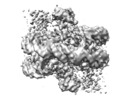

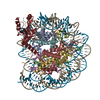

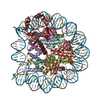



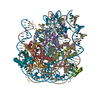




























 Z (Sec.)
Z (Sec.) Y (Row.)
Y (Row.) X (Col.)
X (Col.)






















